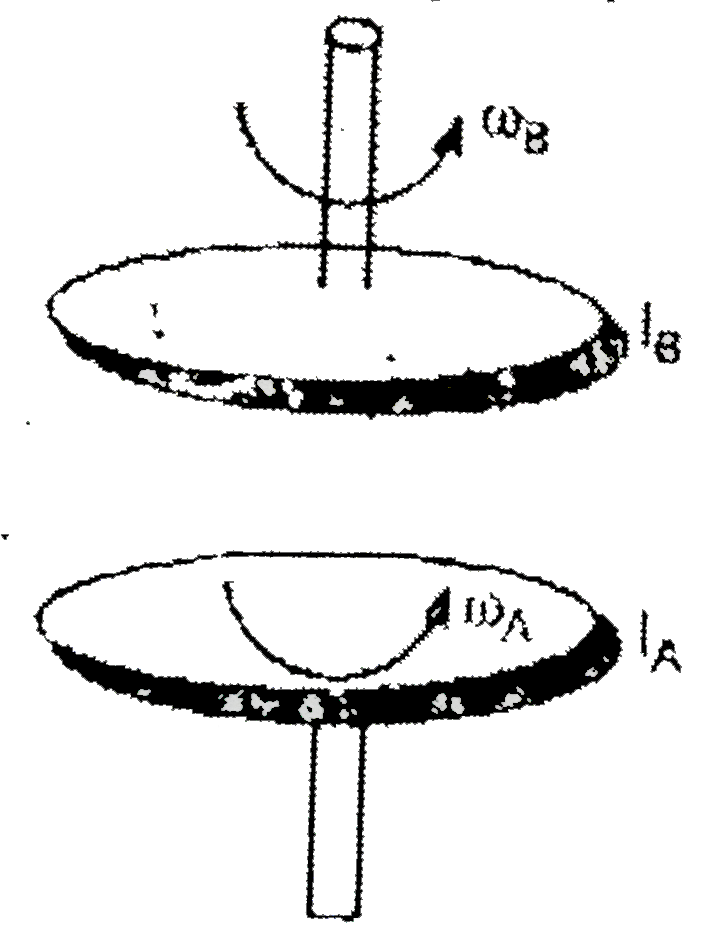A clutch assembly consists of two discs A and B of moment of inertia 2I and I respectively, one being the engine fly wheel, the other one is the clutch plate. The discs are initially rotaing with angular velocities ωA=ω and ωB=2ω as shown in fig. When the two disc are brought into contact the discs rub against each other and eventually reach a common angualr velocity ω.
(a) Derive an expressio for ω
(b) What is the angular impulse of friction on any one of the discs?

Step by step video & image solution for A clutch assembly consists of two discs A and B of moment of inertia 2I and I respectively, one being the engine fly wheel, the other one is the clutch plate. The discs are initially rotaing with angular velocities omega_(A)=omega and omega_(B)=2omega as shown in fig. When the two disc are brought into contact the discs rub against each other and eventually reach a common angualr velocity omega. (a) Derive an expressio for omega (b) What is the angular impulse of friction on any one of the discs? by Physics experts to help you in doubts & scoring excellent marks in Class 11 exams.
Topper's Solved these Questions
- BOOK - ANURAG MISHRACHAPTER - RIGID BODY MOTIONEXERCISE - SCQ_TYPE83videos
RIGID BODY MOTION
- BOOK - ANURAG MISHRACHAPTER - RIGID BODY MOTIONEXERCISE - MCQ_TYPE41videos
RIGID BODY MOTION
- BOOK - ANURAG MISHRACHAPTER - IMPULSE AND MOMENTUMEXERCISE - matching3videos
IMPULSE AND MOMENTUM
- BOOK - ANURAG MISHRACHAPTER - UNIT AND DIMENSIONSEXERCISE - Matching Type Problem4videos
UNIT AND DIMENSIONS
Similar Questions
Two discs A and B are in contact and rotating with angular velocity with angular velocities ω1andω2 respectively as shown. If there is no slipping between the discs, then
 View Solution
View SolutionTwo coaxial discs, having moments of inertia l1andI12 are rotating with respective angular velocities ωandω12 about their common axis. They are brought in contact with each other and thereafter they rotate with a common angular velocity. If EfandEi are the final and initial total energies, then (Ef−Ei) is:
View Solution
Knowledge Check
- Question 1 - Select One
Two balls A and B of angular velocities ωA and ωB collide with each other. Then, after collision
Aboth have same angular velocitiesBωA>ΩBCωA=ωB when balls are smoothDωA>ωB when balls are smooth - Question 2 - Select One
In the above question disc B is brought in contact with disc A, they acquire a common angular velocity in time t. The average frictional torque on one disc by the other during this periodis:
A2Iω3tB9Iω2tC9Iω4tD3Iω2t - Question 3 - Select One
Two discs of moment of inertia I1 and I2 about their respectively axes (normal) to the disc and passing through the centre) , and rotating with angular speed ω1 and ω2 are brought into contact face to face with their axes of rotation coincident .
What is the loss in kinetic energy of the system in the process ?AI1I2(ω1−ω2)22(I1+I2)BI1I2(ω1−ω2)2(I1+I2)CI1I2(ω1+ω2)2(I1−I2)DI1I2(ω1+ω2)22(I1−I2)
Two discs of moments of inertia I1 and I2 about their respective axes (normal to the disc and passing through the centre), and rotating with angular speed ω1 and ω2 are brought into contact face to face with their axes of rotation coincident. What is the loss in kinetic energy of the system in the process?
View SolutionTwo discs of moments of inertia I1 andI2 about their respective axes (normal to the disc and passing through the centre), and rotating with angular speeds ω1 andω2 are brought into contact face to face with their axes of rotation coincident. (a) What is the angular speed of the two-disc system? (b) Show that the kinetic energy of the combined system is less than the sum of the initial kinetic energies of the two discs. How do you account for this loss in energy? Take ω1≠ω2
View SolutionTwo coaxial discs, having moment of inertia I1 and I12, are rotating with respective angular velocities. ω1 and ω12, about their common axis. They are brought in contact with each other thereafter they rotate with a constant angular velocity. If Ef and Ei are the final and initial total energies, then (Ef−Ei) is:
View SolutionA heavy disc is rotating with uniform angular velocity ω about its own axis. A piece of wax sticks to it. The angular velocity of the disc will
View SolutionA disc rotates with angular velocity ω and kinetic energy E. Then its angular momentum
View Solution

